Lewis and I returned to Scandinavia for a summertime adventure. We travelled to the Kingdom of Norway. We are travelers who enjoy creating stories, and this one is very pleasurable. Sit back and relax as you come vicariously with us.
Norway is certified as one of the happiest places on Earth for 2023, as seen here...
It was marvelous! Lewis and I cherished the majesty of its landscape and the purity of its culture. Every time that we travel to Europe, it’s an immersive experience in normalcy: friendly people, clean cities, vibrant evenings (but quiet sleep-times), modern infrastructure, and functional transportation. Those are things that we don’t usually get in New York City.
Once again, we purchased tickets aboard Norse Atlantic Airways because we loved our experience with them flying to Germany, last autumn. Their logo is a Viking longship that the ancient Norse culture was famous for.
We splurged and bought Premium (First Class) seats! Each non-stop (direct) Flight in First Class cost $530, including two full meals, priority check-in, and priority boarding. Compare that impressive value against a typical airline in America: greedily overpriced for the same trip: $2,984!!!
Evading that ripoff, our total roundtrip investment was $2,215 for a prime-time "summer vacation" to Norway’s most-popular city.
Having dreadful experiences flying out of NYC during the past two years, Lewis and I wanted to avoid the TSA: an outsourced agency that the government overpays to provide Security Screenings at airports. Since it started, the TSA is notorious around the world for ineptitude, failing almost all "undercover tests", and causing hours of unnecessary delays for millions of fliers.
Typical of the uncaring USA, the only thing that overpaid authorities at JFK Airport did was write a “strongly worded letter” to the TSA. It merely reprimanded their uncaring that created long lines and delays. Nothing severe happened. That was in 2016. No consequences occurred since then, despite surging delays each year. Thousands of delayed passengers are ignored, and the countless delays to planes and airlines are disregarded. That is typical. A website named iHateTheWait encourages flyers to vent frustrations to warn others. Use this link to learn about the TSA:
https://halfwindsorfullthrottle.blogspot.com/2015/06/flying-failure.html
In an attempt to avoid what the USA won't improve, we paid extra for a program named TSA-Precheck. It grants you an "express checkpoint" so you skip the long queues, keep your shoes on (which is normal in every country but America), and avoid high-intensity screenings.
The TSA doesn't make the registration easy. They claim to, but that is false advertising (nothing new in the USA). Using its circuitous website, we located a TSA-Precheck Center near us (businesses that were contracted to do questionnaires for TSA). Lewis and I scheduled our appointments on different days because of our schedules and their available time-slots. He went on Friday, and I went on Saturday. His confirmation arrived within two days, and mine required two months... because data is randomly assigned to TSA centers around America. Lewis' data went to an efficient one; mine went to a backlogged one. I tried to call the TSA to check on my status, but their system was not designed to provide it. That is immensely stupid. This is the year 2023, so a lack of information-sharing is absurd.
When we finally got our TSA-Precheck ID Numbers, we tried to apply them to our airline tickets, but the website for Norse Atlantic said, "TSA-Precheck Coming Soon". That was in the month of March. I phoned Norse, and their representative said that they didn't participate in TSA-Precheck yet... but they would. By August, their website still said "TSA-Precheck Coming Soon". Pathetic.
I phoned the TSA, and the representative told me to try having an airport employee at Norse Check-in add our Pre-Check Numbers onto our boarding passes. That was idiotic advice... but we tried it anyway.
Getting home from work during the evening of our flight was fraught with troubles... because we currently live in NYC, which doesn't care about fixing its antiquated subway. Just as I got on a train, an alert was issued that all trains leaving Manhattan to Queens were suspended because of a mechanical issue on a train at the tunnel. Since the trains on that route are from 1973, it's a reoccurring problem, but NYC doesn't get penalized to fix it.
At JFK's decrepit airport (mostly unimproved since 1979, except for a repaved parking lot and a new facade), none of the Norse employees were Norwegian. They were all minority ethnicities who seemed unimpressed with their jobs. Regardless of our First Class status, the Check-in attendant was rude and blatantly unhelpful. She weighed Lewis' carry-on suitcase and stated that it was one pound overweight. Therefore, she insisted that we either discard items or pay $90 to have it designated as "Checked Luggage" to be stowed inside the plane. We had no alternative. [On our return flight, the Norwegian employee for Norse never weighed our luggage and happily gave us a cheery experience. However, Lewis had already gone online to pay $50 for the "Checked Luggage". That proved again that service in America is dreadful, compared to Europe. We had the same thing when flying on Emirates, last year].
We inquired with another attendant about TSA-Precheck, and she said, "We don't have anything to do with that." That wasn't a clear answer, so we asked again. She huffed, "We don't get involved with TSA." That was peculiar because there was a TSA-Precheck banner in the Norse Airways area! (seen below)
We were agitated because we paid extra to TSA for nothing! We didn't understand how an airline could "opt out" of a national security program?! Our passports worked on whichever airline we travelled, so our TSA-Precheck (authorized by the federal American government) should, too. That is an idiotic system! Furthermore, we were not informed by anyone at TSA, its website, its advertising, or its outsourced businesses that it only worked with "participating airlines". Another scam in the USA.
Feeling dejected, we joined the long queue for regular TSA Security Screening. The wait-time was approximately 25 minutes to get to the checkpoint. There was no air-conditioning, and two swivel fans tried to circulate the air. One corner of the waiting room had broken lightbulbs. Someone remarked sarcastically, "This is how JFK treats customers: no air-conditioning on a hot August night, and blackness!" Frustrated that we paid extra for expedited service but still had to endure JFK's stupidity, we trudged along the long line. Just as we got to the screening machines, a black man from TSA "did a favor" for two black Jamaicans and put them in front of us—cutting ahead of the entire line. Of course, neither man was prepared; their passports were shambles, and one was invalid. Yet, the TSA allowed them to pass through! Their suitcases were unhinged and spilling contents. They delayed everyone. Thanks again, TSA. Making matters worse was our knowledge that the TSA was given $9 billion, this year, to fix delays and long queues at JFK. Once again, American taxpayers can ask, "Where did the money go?"
Then we sat in the mind-numbing blandness of a JFK departure terminal. Despite this being the year 2023, look at the seats and tell me where the e-charging sockets are?
Since 2012, (nearly ten years ago), we saw them provided for each seat in China, Japan, India, and Europe. Still nothing in America's richest city.
Mercifully, our experiences with airlines from Nordic nations is that they hospitably allow their passengers to get aboard their planes as soon as possible. (We enjoyed that nice treatment from Finn Air, Norwegian Air Shuttle, and Norse Atlantic). Other airlines uncaringly make their customers wait in JFK's dirty departure areas until the last moment. Happy to be using Norse, we climbed aboard our jet: a new Dreamliner powered by Rolls Royce engines.
Ensconced in Premium Class, we nestled into our oversized leather seats, and I loved the generous legroom.
While everyone else stowed their luggage, we were offered juices and water.
We were near five joyful friends going to Norway to celebrate a woman's 25th-birthday. That enlivened us because we were going to celebrate mine (belatedly). We were grateful to become airborne on-time, and we peered from our larger-than-average windows to watch NYC's squalor fall away. Soaring over the ocean, we enjoyed the pop of champagne, and we sipped bubbly while perusing the sizable repertoire of films. Many were great.
Thanks to Fate, we always encounter someone from the nation that we intend to visit, just before our trip. A week before our journey, Lewis met a flight attendant for Norse Atlantic! He raved about Norway but was not scheduled to be on our flight. Next time, we'll try to be on his flight, and he'll upgrade us to First Class for no additional cost!
Our flight crew wheeled trollies of beverages, and we requested mini-bottles of white wine. Our smiley Norwegian attendant graciously gave another bottle to both of us when serving our dinner. We skipped coffee, reclined our plush seats, extended the footrests, and watched movies. With a gay flair, an attendant approached me and proffered a third bottle of wine... for my recent birthday. Gushing thanks to his blushing smile, I nestled under my soft blanket, sipped, and drifted to sleep. Our transatlantic flight was serene without turbulence.
In the morning, as we flew over the Norwegian Sea, we ate a savory breakfast sandwich, drank orange juice, bypassed tea, and enjoyed Norway's greenery through the windows.
This is the Norwegian flag and coat of arms.
Featuring an axe-weilding lion, the coat of arms is one of the oldest in the world, from 1225.
The design of its flag is akin to other Nordic nations (as seen below). They remain tight-knit and use the Nordic Cross in their flags. In 2022, the King appointed Anne Tvinnereim to the ministerial job of Nordic Cooperation. Having a governmental role for cohesion is indicative of "good neighbor" policies.
Norway is a Nordic nation, and it is one of three Scandinavian nations in the world. Scandinavian nations are kingdoms: Denmark, Norway, and Sweden. Nordic nations include those kingdoms, Finland, Greenland, the Faroe Island, the autonomous region of Aaland, and the island-nation of Iceland.
We landed 20-minutes earlier than planned... which was wonderful. It was our second time being on the Fennoscandia Peninsula. Our jet "touched-down" in the County of Viken. Lewis and I were some of the last people to enter Viken.
Abiding by its constituents, the Norwegian Parliament will dissolve the county and revert back to the separate territories that existed before the 2020 merger. That will occur next year on January 1. Most locals are happy with that, and we admire how the politicians of Norway heed their citizens.
Oslo's international airport was a delight to use!
The area's history began in 1740 as an army base for regiments of Cavalry and Dragoons. In 1912, it became a site for military flights, and that evolved into a civil airfield. Now, it is an emporium of sleekness, quality eateries, efficient luggage retrieval, and cheery Customer Service (some helpers have yellow uniforms to be easily identifiable).
Instantly, T-mobile provided great service for me.
At the Customs Checkpoint, we enjoyed a efficient-moving promptness that allowed us to breezily pass through. The Royal Ministry of Justice and Public Security does a fine job. There were automated border control gates, but we were queued for officers to inspect us.
While our passports were screened, an older fellow inquired politely about our itinerary. He was thrilled with the intensity of our visit in his homeland: no tourist-traps and purely full of local specialities. (Whenever we travel, Lewis and I opt to appreciate local heritage, history, and cuisine). When I mentioned our intention to use a treetop zip-lining park named Skimore Summer Park, he didn't seem to recognize it. But he wished us a pleasant time.
Surrounded by Scandinavian sleekness, we were impressed with the airport: lots of wood details, the cleanest lavatories imaginable, orderliness, spacious shops, and a bright & airy milieu.
From the airport, we needed to go to the County of Oslo, which is its own administrative region (similar to Italy and China) because it is the capital. Every county has a governor who represents the King and government to ensure that parliamentary goals are completed.
It was easy to get to the airport's train station. None of the airports in/near NYC are connected to it by trains. It's been like that since 1939. Despite its traveller-density, NYC has no intention of investing in overdue infrastructure to fix that. Oslo is a truly first-world city and offers two rail options from its airport: regional trains and an Airport Express train. Curious about the experience, we indulged ourselves with the express train, named Flytoget. It was super-easy! With our suitcases rolling along the glossy marble floor, we walked to the escalators for the station. You must have access through the transit gates. Norway doesn't use turnstiles (NYC still does, and they smear uncleaned dirt on your clothes). A suited gentleman spoke fluent English and told us to merely tap our credit card on the machine to purchase one-way tickets: $22 each. Within two seconds, both of us passed through and waved our thanks to him.
Currency in the kingdom is measured in crowns, and one krone = $0.10.
Norway does not use the Euro for money, and it is not a member of the European Union, yet it belongs to Schengen Area. It remains one of the richest and most-prosperous nations in Europe.
Elevators and escalators took everyone down to the open-air train station.
Easy-to-read screens (in Norwegian and English) identified which incoming trains would arrive on which tracks. Express trains are painted with a silver livery.
Americans must configure themselves to timetables that use 24 hours, instead of AM & PM. Almost all countries in world use a 24-hour system. But America inconveniently remains one of only five places that uses a 12-hour format split into AM and PM. Everywhere else, if your appointment is at 9 in the evening, it is not 9pm; it is 21:00. Americans must also get accustomed to kilometers, instead of miles. Despite 195 nations using the metric system, only America, Liberia, and Myanmar obstinately use the imperial system of miles, gallons and pounds for measurement. Also get prepared to write dates as Day-Month-Year because that is how most of the world does it. The Month-Day-Year format is only used by America and Micronesia.
Travelers can also get from the airport by buses or taxi... and Norway elegantly uses many BMW and Mercedes taxis.
Whenever possible (outside of the USA), we choose the convenience/speed of rail.
Every year, Flytoget is voted as the Best for Customer Service in Norway! Its trains are as wide and high as possible, for sizable comfort. They are impressively sleek: recessed lighting (overhead and near the floor), digital screens, motion-sensor glass doors between compartments, upholstered seats with leather trim, headrests, hinged armrests, and e-charging sockets and cupholders for every seat. Luggage racks have glass panels so you can see that your things are safe. There are wood accents everywhere: sides of seats, undersides of armrests, window frames, and surrounded the cup holders. Everything is designed to be calming.
The locomotive hummed quietly—ensuring that riders have a tranquil experience. Trains operate with electric power that is guaranteed to be sustainable. Stand-up desks exist with padded areas to lean back on and are slightly enclosed by glass walls. All of the windows have motorized shades. Bicycles are accommodated. There are cozy nooks for people to use laptops or have chats. Passengers in wheelchairs or strollers are not positioned in corners (as on other trains); they are able to be near their friends who sit on regular seats.
Large screens provide weather reports, a calendar of events in Oslo, and helpful ads. It also had a machine that scans your flight’s boarding pass and prints a bag-tag, so you can avoid that queue at the airport!
The train left the station with the smoothness of a Ferrari, and it accelerated without noise or shudders. That is how train travel should be.
The smiley conductor saw us photographing the train. We explained that we don't have high-speed trains or trains from the airports in New York City. Ha ha! Norway is a long nation, so it sensibly invests in fast trains. The USA is much bigger but remains greedy/cheap, so it refuses to build truly fast trains.
We were thankful for the Norwegian Railway Directorate, which reforms and modernizes the kingdom's rail network.
The train zoomed south and entered the capital: Oslo. The capital encompasses 11 boroughs with a total population of 1,064,235. It is the seat of the Royal House and the government: parliament, ministries, and treasury. This is the 32nd year in the reign of King Harald V of Norway. Here is his Royal Cypher.
Oslo's coat of arms originated in 1300. It depicts Saint Hallvard (born in 1020), who is the patron saint of the city. At age 22, he defended a pregnant slave woman by giving her sanctuary in his boat. Her three male attackers didn't recognize the popular hero and shot him with arrows until he died. Fearful from their error, they tied a millstone around Hallvard, so his body would sink and never be found. Allegedly, it miraculously refused to sink, and villagers provided justice. Hence, the coat of arms shows the maiden at his feet, while he holds the deadly arrows and millstone.
From our comfy seats, we admired the high-rise buildings nicknamed The Barcode, which lined a road near the Central Station. Those buildings got their nickname because of their varying shapes and proximity to each other. Oslo dislikes skyscrapers and prefers to preserve its sunlight by keeping most buildings below 63 meters (207 feet).
The city was officially named Oslo in 1925. At that time, the "name change" reverted back to the original! I'll explain. In old Norse language, the word oslo indicated a “river marsh of the gods”. The word “Oslo” was first recorded in 1225 as the name for the original settlement. It is the oldest of the Scandinavian capitals. It was founded by King Harald Hardrada in 1049.
In 1070, the city was elevated in status to a bishopric, ruled by a Catholic bishop. The Roman Catholic Church owned much of the city’s land. Hypocritically disregarding Jesus’ teachings that churches should not be for profiteers, the Church became a huge money-maker and a governing organization that constricted influence on nations and kings. In 1299, King Haakon V ascended the Throne and made Oslo his home. Therefore, it instantly became the capital of the country. He erected the city' fortress, which stands as a popular national monument and tourist site.
Royal power within Norway was centralized in Oslo, and that continued through the Middle Ages. The Black Death plague came in 1349 and killed half the population. That destroyed the Church’s tax-free income, and it dwindled. Traders of Europe's almighty Hanseatic League absorbed its power and bolstered Norway. In 1397, Norway joined Denmark and Sweden via the Kalmar Union, so Oslo lost importance because Copenhagen became the capital of those united kingdoms. The union disintegrated in 1523, but Norway was taken by Denmark.
The Great Fire of 1624 caused massive reconstruction at Oslo, and the rebuilding occurred closer to the fortress, on the other side of the fjord. The new community was named Christiania, in honor of King Christian IV of Denmark, who ruled Norway as a joint-kingdom.
The name Oslo remained for the outer area. Wealth soared from shipbuilding for Europe’s battles and businesses. Norway’s biggest mercantile partners were Great Britain and the Netherlands, due to their huge global networks (East India Companies). In 1716, the King of Sweden invaded and looted the city, but his troops couldn’t capture the fortress, so they retreated. In 1814, the Treaty of Kiel forced Denmark to give Norway to Sweden, but Norway was reinstated as its own kingdom… and Christiania was the capital. During the 1860s, enlightened people esteemed Oslo higher, so they congregated there. After the 1905 Dissolution of the Union between Norway and Sweden, public opinion pushed for the name of Oslo to return and replace the Danish one. Parliament ratified it on January 1, 1925. That's an impressive history!
The train glided into the Sentralstasjon (Central Station), and we disembarked onto the platform.
Every train and Metro station in Oslo is equipped with ramps, elevators, and escalators. Unlike overpriced NYC, customers never have to hoist their luggage or baby strollers up/down stairs! Seen below, the lighting in the onramp into the station looked futuristic.
The high-ceilinged interior is impressive and modern, and vintage areas are repurposed for eateries.
Brainwashed from their "car culture", Americans may want to drive themselves everywhere... but cars are not needed. It is better to use the marvelous public transit and your own two feet.
At the Ticket Office, a young man sold us two weekly transit passes for unlimited usage of trains, Metros, trams, buses, and ferries. Each cost $30. (For a weekly pass, New Yorkers pay $34 for a dilapidated system that is full of delays, cancelations, and overcrowding).
The man was enthused that we were New Yorkers, and he felt proud that we chose to visit his country. Congenially, he asked if we needed directions to our hotel? (We never get that type of consideration from transit workers in NYC). We gave the hotel's name, and his reaction assured us that it was a posh place. Gesturing to the west, he said we could walk there in 10 minutes, because the hotel was on a pedestrianized street that led directly to the front of the station. Nonetheless, we saved our luggage-wheels from the cobblestones and rode the Metro.
Similar to our time in Berlin, the major Metro routes converged when going through the city-center, so any train would take you to your destination. Our hotel was at the next westbound station. (We choose hotels for their centralized locations and proximity to public transit).
The Metro stop is not named Central Station. It is named Jernbanetorget.
We rode steep escalators down to the platform. Seen below, those images were not posters on the walls; they were video screens that showed ads and train notifications. Nothing like that exists in America's richest city... and riders are lucky if the escalators function.
Oslo is another city that is unlike NYC by having a loop in its Metro system to allow citizens access through the city. The loop connects all routes.
That's a big change from what we deal with in NYC. Unchanged since 1910, NYC's subway system is uncaringly only a funneling method to bring workers into Manhattan from their boroughs. It doesn't care to give citizens access between the five boroughs. Despite a huge population of 8.5 million and more revenue than any system in the world, there is no loop; riders must exit one train, walk to a connecting station (or go aboveground and walk to a nearby station and go downstairs again) and wait for another train.
Being in a first-world nation like Norway that actually treats its citizens as if they lived in a first-world nation was a joy for us. We breathed a sigh of gratitude to Norway's Royal Ministry of Transport, which has been responsible for it since 1946.
Just like in Berlin and Dublin, Oslo's public transportation doesn't have turnstiles or gates; passengers use a "tap-and-go" system when entering.
Seen above, there are validator kiosks ("readers") on Metro platforms, and riders can also tap their transit cards on screens within the trains. For trams, buses, and ferries, riders tap on screens after they get inside. If you have a paper ticket, you insert it, and the validator stamps the time/date. You only have to insert it once during the validity of your ticket! That will tell Transit employees when you activated it.
Metro trains arrive within a few minutes of each other! It was heavenly! Customers never have to run to catch trains because another one arrives within moments. The system is reliable, modern, and clean.
Since it was midday, the trains were less crowded.
We emerged at Stortingnet Station. By accident, we walked to the opposite end of the station and emerged at Prince's Street. There was a ramp to the sidewalk. Such conveniences don't exist in NYC.
Please watch my short video of the pretty scenery...
Correcting our direction, we headed for the hotel. (Oslo benefits from a low skyline, and that makes it easy for pedestrians to see landmarks and know which way to walk). We strode across a leafy park and saw our beautiful hotel in a Beau Arts buildings that was constructed in 1899 on (King) Karl Johan's Street. With 157 rooms, the Karl Johan Hotel is a corner-property located across from the Parliament and down the street from the royal palace. It was founded in 1874 by two sisters named Marte and Marie Larsen.
Seen in the progression of pictures below, there has been a hotel in that place for almost two centuries.
We were enthralled by its classism. The lobby retains its historic charm, with a grand staircase and a gorgeous banister.
It wrapped around a modernized glass elevator that reminded us of classic ones in turn-of-the-century hotels.
Like many European societies, Norwegian hoteliers believe that customers should enjoy flowers and candle-glow during mealtimes and throughout every evening. Therefore, each evening, the hotel's staff ignited pillar candles in the lobby, lounge, and on the staircase. There were always fresh flowers on tables everywhere. Delightful.
The Front Desk was staffed by a young Asian man and a young Norwegian woman. She was the smiliest person imaginable, and she got us acclimated. Norwegians speak fluent English, and we never encountered anyone who didn't. It is used as a lingua franca: a common denominator to join visitors from every part of the globe. In Norwegian, Lewis' name is "Ludvik". My named doesn't translate, so it remained as "Kenneth"; it originated with ancient Gaels to mean "handsome lord born of fire". "Lewis" has Frankish-Germanic origins to mean "loot-carrying warrior".
She issued our key-cards and summoned the elevator. It was the cleanest elevator we ever saw: every mirrored surface and pane of glass remained smudge-free and smear-free—polished to a gleaming shine! Merely riding it in made us smile, each time.
As usual, Lewis chose our hotel via Booking.com, and his status as a Genius Level 2 gave us a discount and a room upgrade. Karl Johan's Street bubbled with nighttime restaurants, a jazz bar, and pedestrians who crisscrossed the city. So, we picked a room that got sunlight but faced a quiet courtyard. It was perfect.
The hotel was built on two interconnected buildings, so there are occasional steps (3 or 5) when you cross between parts. (To avoid that, you can use rooms in the front half). We didn't mind; it was quirky and fun.
Priced at 14,133 crowns ($1,289) for seven nights, our queen-sized room had a comfy bed, firm pillows (per our preference), two tall windows, a strong air-conditioner (even though Norway has perfect summer temperatures), a closet, desk, two leather chairs, and a cushy bench near the door (to use when putting on shoes). (Norwegians remove their shoes when they enter a home or hotel room). The bathroom was immaculate: every metal surface shone with perfection.
We used the see-through shower, and we liked the brand of "Ritual of Karma" soaps. The bottle had a quote of Zenful wisdom: "Living with good intent attracts good karma. Do good, and good will come your way." That seemed to embody the Nordic way of life.
The sink was small, so Lewis misjudged himself and splashed water all over the floor. I didn't see any housekeepers in the hallway, so I went down to the Front Desk to explain what happened and request extra towels. The young woman laughed in agreement that some sinks can cause that to happen. Within moments, she personally delivered towels to our room, and gave the sincerest smile.
Lewis and I decided to unpack later because we were hungry, and there was a lovely cafe around the corner on Rosenkrantz Gate. That street is painted with the colors of a Pride Flag, and it is used for the annual Pride Parades.
Unlike American cities, Oslo doesn’t have a “gayborhood” because homosexuals don’t feel the need to cling together in their own area. They live harmoniously throughout all neighborhoods. *To see what I refer to, please use this link: https://halfwindsorfullthrottle.blogspot.com/2016/06/gay-kids-have-it-easier.html
Our satisfying meal cost 485 crowns ($44). A tip was not expected because Norway has a non-tipping culture.
After that, we had an imminent appointment at the palace! We went there straightaway.
During the prior week, it hosted an open-air Summer Concert that was free to all. We watched that symphonic performance online. It was immensely fun and vivacious, and it reminded us of the annual ones that we watch on TV from the Summer Palace in Vienna, Austria.
*To learn about Vienna's summertime concert, please use this link:https://halfwindsorfullthrottle.blogspot.com/2020/09/summer-concert-in-park.html
The royal residence is at the top of the capital’s thoroughfare: Karl Johans Gate (gate means street). Thankfully, our hotel was directly downhill from it. The City of Oslo invested in planting 23,000 flowers along the street. Lewis and I were impressed with the natural cleanliness of the urban landscape. We’re not accustomed to that in the overpriced city where we live.
Using a street named for King Karl Johan was significant for our visit to the palace because he was the king who propelled Norway onto its path of sovereignty and modernity.
There is a statue of Karl Johan—astride his steed—in front of the palace that he built.
Interestingly, the palace is not named for anyone: it is succinctly known as The Royal Palace. (In other nations, palaces are named: the Forbidden City, Versailles, Buckingham Palace, Charlottenburg Palace, Za'abeel Palace, Dechencholing Palace, and Amalienborg Palace). Unlike Buckingham Palace in London, Oslo's palace abides by the Scandinavian style of openness and accessibility to its citizens. There are no barriers, barricades, fences, or gates. We remembered the same thing during our time in the capital of Denmark.
Nevertheless, the palace is guarded by foot-soldiers of The King's Guard. Impressively, sentries are posted around the permitter of the palace 24-hours-per-day, throughout the year.
In other countries, guards must remain straight-faced and only pace back-and-forth. Indicative of Norway's convivial and "chill" culture, its royal guards are permitted to talk with you. You can speak with them (if you initiate it), and they will pose for photos with visitors.
When on duty, the royal guards literally "look around": left, right, and down. We're uncertain why they look down.
I'll show you more about the royal guards (gardekompani), in the next part of my blog.
In 866, Norway was unified from several kingdoms into one.
The leader of that accomplishment became its first king: Harald Fairhair, born in 850. From Viking conquests, Norway gained Overseas Territories. The Isle of Man (now famous for a gay actor, Joe Locke, who stars in Heartstopper) and the Shetland Islands (famous for wool) were colonized in the 880s. Later, Norse Vikings invaded Ireland and instituted suzerainty over the Kingdom of Dublin. Those settlers absorbed Celtic beliefs. *To see when Lewis and I viewed the parts of Dublin Castle that they built in Ireland, please use this link:
https://halfwindsorfullthrottle.blogspot.com/2023/02/our-trip-to-dublin-ireland-part-4-of-6.html
In the 1100s, Norway conquered Iceland, Greenland, and the Faroe Islands. Another branch of Norsemen were led by William the Conqueror to take England in 1066.
During the medieval era, Norway, Denmark, and Sweden (which owned Finland) had the same monarch. The joined kingdoms were renamed as the Kalmar Union. The scheme was created by Denmark’s Queen Margaret I in 1396. It endured until 1523 when Sweden seceded for independence via its War of Liberation. In 1814, Denmark gave Norway to Sweden, but Norway fought for sovereignty and won in 1905. Norwegians wanted their nation to have its own Sovereign, and the government sent envoys to scrutinize candidates. The people voted for their monarch! Denmark’s second-born prince, named Carl, was elected to be the Norwegian king.
... and he changed his name to Haakon VII for his coronation.
His dynasty continues. In 1896, he married a British princess named Maud.
She was the youngest daughter of England’s King Edward VII. Norwegians were thrilled that their new queen was from the United Kingdom because that gave them prestige and an alliance to the British Empire (the biggest and most-powerful).
The royal pair survived both World Wars. Their heir was born in 1903: Crown Prince Alexander.
He fell in love with the Crown Princesses of Sweden and they married in 1929. They had three adorable children.
During the Nazi Invasion and Occupation of 1940...
...they fled to safety in England: one of the few sanctuaries in war-torn Europe. Alexander sent his wife and children farther to the USA, where the American President, Franklin Delano Roosevelt (married to his lesbian cousin and known for his extramarital affairs) fawned on Alexander's wife.
Before our trip, Lewis and I watched the BBC series titled Atlantic Crossing. It aptly portrayed FDR as a playboy and a president with a lot of bluster but little “action”—just like his uncle, President Teddy Roosevelt. (If you know history, you’ll agree). Crown Princess Märtha dealt with it to garner support for her struggling country.
*To see when we visited FDR's home, please use this link:
https://halfwindsorfullthrottle.blogspot.com/2015/09/our-trip-culinary-institute-then.html
Crown Prince Alexander’s wife died prematurely in 1954 in Oslo. In 1957, his father died in the palace, and he became the widowed King of Norway and Head of the Church of Norway.
As King Olav V, his reign saw technological advancements and gained huge popularity. He travelled extensively and mingled with his people without bodyguards because he was well-loved. In 1991, he died at the age of 87. His son Harald became King Harald V.
In June, Lewis and I browsed the webpage of the Norwegian Royal Household, and we discovered that the King and Queen resided in the palace most of the year, but they summered elsewhere. That allowed the palace to be open for guided tours, from mid-June until mid-August. The final tours occurred on August 17, which was the date of our arrival in Norway. Immediately, we made an online purchase for two tickets; we snagged the last tour that was given in English. Hooray! The total cost was 350 crowns ($33). Thus, our jet landed at 1pm, and we arrived at 3:30 for the 4pm tour. We were grateful for Norway's efficient airport check-in, transit system, and priority for pedestrians on streets!
Seen below, the palace is stately.
Visitors assemble at the palace's rear garden-courtyard, surrounded by lush grounds.
Lewis and I bypassed the queue because we had e-tickets. A greeter scanned them from Lewis' phone and invited us through the gates into the courtyard. Since it is a royal residence, a handbag scanner and body scanner were used for security. We meandered into a large pink vestibule: a double-height room with Roman columns.
Wearing uniforms, two men instructed us to use lockers for our cross-body bags. Visitors keep the locker-keys until they leave. Visitors must wear plastic shoe-covers—an indication of a clean society. A corner of the room was used as a Gift Shop, but the items were uninteresting. Compared to mementos of royalty in the United Kingdom, that was a "missed opportunity" for Norway. Perhaps the casualness of Norway extends to a lack of regal souvenirs.
Things in Norway are punctual, and we like that. Promptly at 4pm (16:00), a docent named Batina welcomed us to the last English-spoken tour of the year! We were in a group of 30, and everyone applauded. Other visitors were American, French, German, English, Chinese, and Vietnamese.
We started by discovering Norwegian royalty. Norways's monarchy was established 1,151 years ago, but its current Royal Family has a "recent" beginning in 1906.
Due to lapses of independence in Norway, the term “Norwegian Royal Family” can refer to those ancient ones or the contemporary one from 1906. This Royal Family is from the House of Glücksburg.
It is a cadet branch of the House of Oldenburg, from Germany, founded in 1101. In 1460, the Town of Glucksburg became ruled by Count Christian of Oldenburg, and—in 1448—he was elected by Danes as their king: Christian I. Due to arrangements of that era, he was simultaneously King of Denmark, Norway, and Sweden.
Norway's constitutional monarchy strives to connect two eras of Norway's independence: its ancient monarchies, and after Norway seceded from Sweden in 1905. This is the Royal Family's coat of arms, and it is the coat of arms of the nation.
The Kongehuset (Royal House) includes the King, Queen, Crown Prince, his spouse, and their eldest child. Separate from that is the Kongelige Familie (Royal Family): the monarch’s siblings, other children, their spouses, and the monarch’s grandchildren.
King Harald V is 86-years-old, and his vivacity is a testimonial of sturdy Norse genetics. When he was the Crown Prince, he became smitten with an Osloite named Sonja Haraldsen.
Alas, his father and the courtiers objected because she was a commoner. (Her father owns a clothing manufacturing company, and she attended “finishing school” in Switzerland). The next year, Harald enrolled at Oxford University in England. He was athletic and excelled at rowing and sailing. He studied economics and politics. He maintained his relationship with Sonja—even when representing his kingdom at yachting championships in Japan, Mexico, and Germany. Remarkably, the duo kept their intimacy a secret from the public for nine years. Finally, after nearly a decade of dating, Harald notified his father that Sonja was the only person whom he wanted to marry. As the sole heir-to-the-throne, he leveraged his role and won. His wedding occurred in 1968 at Oslo Cathedral, and the bride eschewed a tiara to have flowers woven into her hair. 850 guests attended.
They have a daughter...
In 1996, the Crown Prince met a young woman named Mette-Marit at a rock concert, and there was a spark of mutual attraction. She was a waitress, college drop-out, and single mother. It didn’t matter to the royal family. The prince’s parents had similar dynamics with their romance, so they understood that marrying for love/chemistry is more important than marrying only for a noble lineage. In rapture, the King gave his blessing for them to be betrothed.
The royal pair have two children: Princess Ingrid and Prince Sverre.
They have a half-brother. Mette-Marit's firstborn son, named Marius, is a 26-year-old motorcycle repairman. His father was a convicted felon who had a fling with his mother. After attending college in California, USA, he returned to nation, where his mom is destined to be its Queen-Consort. He dated a former Playboy model, his current girlfriend is a TV actress, and he has no royal responsibilities... but some benefits.
Currently, there are 43 nations with sovereigns, and most have royal courts that are staffed by courtiers. Det Kongelige Hoff is The Royal Court, which works at the palace.
Their Majesties meet with the Lord Chamberlain to plan trips across the nation and abroad. His name is Olav Heian-Engdal.
Following our tour-guide, Lewis and I entered the palace's main hall. The palace was erected by royal command from King Charles XIV John (Karl Johan).
He was King of Sweden & Norway from 1818 until his death in 1844. Born in the Kingdom of France in 1763, his father was a lawyer who encouraged him to serve in the Royal French Army. The French Revolution altered his career, yet he rose with prominence to the rank of brigadier general. In 1805, he was awarded the Order of the Black Eagle (the highest order of chivalry) by the Kingdom of Prussia. When the megalomaniac named Napoleon Bonaparte controlled France, Johan gained seniority in the Imperial Army.
In 1810, Johan was chosen as heir-presumptive to the childless King of Sweden. (Before the King chose Johan, he adopted a Danish prince named Christian in 1809. That man was Sweden’s Governor-General of Norway and was hugely popular in Norway. He died mysteriously while horseback riding in 1810. A Swedish nobleman was accused as his murderer, and the people lynched that man).
As the new Crown Prince of Sweden, Johan relocated there, ingratiated himself with its government, and defended it against an invasion by France. (No, he did not help France win; he remained steadfast to his new nation and used his military knowledge of French schemes to defeat France). His tactical maneuvers rendered him a hero during battles.
He used his connections and diplomacy to gain alliances with King George III of the United Kingdom, as well as the Russian Empire. In December 1813, he invaded Denmark with a battle-hardened army. He compelled the Danish king, Frederick VI, to cede Norway to Sweden… but Norway resisted another “ownership”. Empathetically, in 1814, Johan promised that Norway would not be a Swedish province; it would be its own kingdom—ruled by him as its king. He commissioned a set of royal regalia to include crowns and scepters, which he paid for, and they were intended for any King and Queen of Norway after him and his wife. His reign was full of peace and prosperity. National debt dwindled, and the treasury had surpluses. He gave the Norwegian parliament more power than any other in Europe, and Norwegians were proud of him as an upstanding monarch. He died after his Silver Jubilee at age 81. You will now realize why Karl Johans Gate is named for him.
The Neoclassical palace was designed by a Danish architect named Hans Ditlev von Linstow, who was born in 1787 and lived in Norway. Repeatedly, he fought for funds from Norway's politicians. During construction in 1825, Norwegians were wary of overspending. 30 years earlier, French aristocrats were beheaded because of their squandering. Until then, many palaces—from Prussia to Spain, Portugal, Hungary, Russia, Bavaria, Italy, Poland, and Sweden—were inspired by Versailles. But Versailles was abandoned in 1789... and again in 1814. That is why the exterior of Norway's palace has a simple but elegant appearance. The interior is handsome without being ostentatious.
Proceeding inward, our tour began in the Cabinet Cloakroom. It refers to the parliamentary Cabinet... not a cabinet as furniture. Next was the Cabinet Parlor. Seen below, it contains the oldest furniture that predates the palace because they were brought by King Karl Johan from his prior home.
We segued through a wide doorway into the White Salon. Its gold-leaf made it the most expensive room to build. Completed in 1849 as the Queen's Audience Chamber, it was fully restored in 2022.
From there, we entered through double-doors into the Council Chamber. It is used every Friday. Born to be a king, Harald V possess the privilege to preside over the Council of State and the Prime Minister. As a constitutional monarch, he is entitled to be briefed about national occurrences.
As the kingdom grew, the historic room was joined with its antechamber. That is why two ceilings are visible.
There is no Throne Room in the palace. The Sovereign operates in an egalitarian way, so the thrones are located in the Council Chamber, facing the table so everyone can work together for the betterment of the kingdom. We liked the blue-painted walls that matched the blue horsehair fabric of the chairs, handmade in 1880. Only the thrones for the monarch (constructed in 1845) and the heir (1997) are made of gilt and red velvet. Assembled in 1880, the long table is made of mahogany from the island-nation of Cuba. Hanging over it, an Art Nouveau chandelier brandishes the motto “The country shall be built on the law”.
Designed by Hans Linstow, the throne is upholstered with red and gold, which are the colors of the monarch. Another throne from 1847 is kept in the Parliament building for political context...
...and the third is in Trondheim: the religious capital of Norway.
His Majesty appoints all senior-level civil officials and military officers. The King appoints each member of the Council of State, including the Prime Minister. The Council is the executive branch of government, and it is chaired by the King.
Last year, the Crown Prince's 18-year-old daughter attained maturity was given a gilded chair at the table. Being able to occasionally attend meetings will prepare her for her future duty.
Some Norwegians are fond of the thrones. While watching TV in our hotel, we repeatedly saw a popular show where talent judges sat on replicas of the thrones.
It's interesting that a progressive nation honors its traditional monarchy: a remarkable balance of understanding and respect that explains why it's one of the Happiest Places on Earth. Please watch this quick video where the Crown Princess explains it...
On the second floor is the White Drawing Room. Drawing rooms got their names from their function to draw people together in one place.
Named the Bird Room, the next chamber is used by visitors who await an audience with the Sovereign. In 1843, an artist named Johannes Flintoe embellished the walls with murals of 43 birds in lush gardens, including grouse, pine grosbeaks, bullfinches, sparrows, yellowhammers, crows, and thrushes.
A dragon is also featured! The custom-made furniture is original from 1846: sofas, 12 chairs, mirrors, and tables. Green upholstery blends nicely with the pastoral scenery.
Colored with scarlet and rose, a ceremonial hall was next. It had Roman columns, frescoed ceilings, and handsome flooring.
From there, we were awed by the family’s Dining Room. It has a vibrant color-palate in the style of ancient Pompeii. It was inspired by the Tsar’s private dining room at the Winter Palace.
Painted during three months in 1841, the ceiling fresco features a shirtless muscled fellow with his arm around a woman, and a flimsy robe barely covers his genitals. His naked tush is evident. That is certainly a conversation-starter!
The long table can accommodate 30 guests—often bishops, parliamentarians, nobility, Supreme Court judges, and military officers. Polytheistic gods and goddesses are depicted around the room. The furniture was gifted to King Olav V by friends in Norway to celebrate his 60th birthday in 1963. Royals and their guests use antique porcelain that was handmade in 1780 by a company named Royal Copenhagen in Denmark. There are 1,802 pieces! The sterling silver flatware is named Brazilian Silver because it was owned by the first emperor of Brazil.
The grandiose ballroom is named The Great Hall. Linstow was forced by the parliament to reduce costs on the palace, but he refused to cut costs for this. He was inspired by the royal concert hall in Berlin (we saw that, last year) and the Great Hall in Denmark’s Christiansborg Palace. He imported much of the ornamentation from Berlin.
The parquet floor covers an area of 360 square-meters. The mirrored walls are white and pink, with gilded trim. New crimson curtains adorn the windows, yet their gold fringe is retained from 1846. A minstrels’ gallery is overhead, and the parquet floor served centuries of dancers. The original four candle-lit chandeliers were replaced with electric ones in 1903. The room doubles as an entranceway for guests who make processions into the State Dining Room.
Unlike other monarchies, the King’s anthem is not the national anthem. Appropriately, it is titled King’s Song. Norway’s anthem is titled Yes, We Love This Country. (The violent nation of America has an anthem that mentions bombs and rockets). Written in 1800, Norway’s royal anthem is sung to the melody of God Save the King, which is the royal anthem and the national anthem of the United Kingdom. (When Lewis and I visited Germany, last year, we learned that the Kingdom of Prussia, the Kingdom of Bavaria, and the German Empire used that British melody, too. Switzerland used it for its national anthem until 1961. The Principality of Liechtenstein still uses it for its national anthem. It’s popular!)
The Banqueting Hall is grandly proportioned with walls and ceilings decorated with roses, vines, and chandeliers from the reign of King Oscar II. Electricians were so proud of the new technology (electricity) that they deliberately displayed the wires—adorned with crystals.
That is where State Visits and royal receptions occur, and the maximum occupancy is 225 guests. According to tradition, when the royals enter, The Old Hunter’s March is performed by the orchestra. Speeches are announced with a large brass bell that was gifted from Oslo’s firemen in 1952.
After a typical three-hour meal, the royals exit the room to the tune, The Valdres March. The tables and chairs were made recently in 2010. The porcelain was crafted for the hall by Porsgrunn Porselensfabrikk as an anniversary gift to Their Majesties in 1997. The pattern replicates the frescoes in the room. The stemware was handblown by Hadeland Glassverk. The sterling utensils were handmade in Oslo in 1860 by a silversmith named Tostrup & Thune. Irish linen is used since 2000.
Since it is a home, our tour precluded the private rooms, bedrooms, and guest rooms.
We did not see the King's study (in-home office), but our guide described his duties. The King must provide Royal Assent for any bill to officially become a law. Formally, His Majesty appoints the government according to his judgement. He ratifies royal resolutions, sends envoys to foreign nations, and hosts State Visits. Importantly, the King influences Norway as a symbol of national unity. His Majesty’s annual New Year’s Eve Speeches are candid about positive and negative aspects in the kingdom.
He is the Supreme Commander-in-Chief of the Norwegian Armed Forces.
Norway's military has Viking origins in 955! At that time, King Hakon the Good assembled manpower to protect coastal communities. The King is the Commander-in-Chief of the Norwegian Defense Security Department for counter-intelligence and espionage.
With gold aiguillettes worn around their right shoulders, each Aides-De-Camp is screened by the Council of State for Crown-appointed roles. The Chief of His Majesty’s Military Staff is Nils Petter Granholt.
King Harald V is the Grand Master of Norway’s chivalric orders of knighthood. Established by a Royal Decree in 1943, there are many types of awards: civic achievement, rescue at sea, meritorious service to the King, heroism, outstanding research, police service, The King's Medal of Merit for Industry, et cetera. Of the 49 honors, the most-recent was added in 2016. The Chancery administers the bestowal of medals, and its Chancellor reports to the Lord Chamberlain. Dynastic Orders of Knighthood are granted by the Sovereign as cultural patrimony from the royal family. Created in 1985, the Royal Norwegian Order of Merit is conferred by the King to citizens abroad and foreign civil servants in Norway. Ranks include Knight, Knight First-Class, Commander, and Knight Grand Cross. Initiated by King Oscar I in 1847...
...the Royal Norwegian Order of Saint Olav rewards citizens who help the kingdom and humanity. As per the constitution, the King can bestow them on whomever he wishes without approval from the government.
Constitutionally, the King has the right to grant Royal Pardons to criminals after they were sentenced. The King, Queen, Crown Prince, and Crown Princess are exempt from paying taxes, yet every Norwegian whom we met liked the King and thought he was a "very nice gentleman".
Our tour ended in the Royal Chapel. It was begun in 1843, yet Linstow created its nave and quire in Berlin in 1837. The chapel is still overseen by the Church of Norway for regularly-scheduled services. Its richly stuccoed two-level ceiling is original from 1843. It underwent a magnificent restoration in 2004, retaining an original color-scheme of green, violet, beige, gray, and brown.
Exiting the palace, we smiled at young man who was the sentry at the guardhouse.
We explored Palace Park, which has 54 acres. Unlike the gardens at Buckingham Palace (that are only open to certain members of the public during the summer), those royal gardens have an egalitarian purpose and are always accessible.
There are guardhouses found sporadically around the park, but everyone shares it safely: sunbathers, dog-walkers, picnickers, newspaper readers, joggers, skateboarders, and commuters. We appreciated the work of the Chief Palace Gardener, Maria Kyhn.
Indicative of Norway's focus on eco-friendly agriculture, the acreage is full of lush greenery and perfectly-trimmed trees. The duck pond was serenely pretty. Similar to the royal bee hives instituted by Queen Elizabeth II on an island within Buckingham Palace Gardens, the King and Queen of Norway sustain honeybees on an island at their home, too.
*To see when we received permission to enter Buckingham Palace and sip tea on the Queen’s terrace, please use this link:
https://halfwindsorfullthrottle.blogspot.com/2022/09/our-return-to-london-uk-part-4-of-6.html
We encountered a gazebo with perfect "gingerbread" ornamentation. People used it to read and admire birds in the birdhouses.
The gardens are void of pesticides. Leading an eco-friendly nation, Their Majesties focus on composting and organic weed/pest prevention. Palace Park contains 1,000 trees!
As we proceeded, we noticed the royal stables.
In 1849, they were built as a home for 38 horses. As an equestrian, Queen Maud expanded it and added an indoor riding hall. She modelled it after the Royal Mews in London. After the Nazi Invasion/Occupation of 1940, horses were not kept there, and it became a garage. In 2017, Queen Sonja transformed it into her art gallery.
As a birthday for her, the King commanded the Directorate for Cultural Heritage to assist with the renovation. “The Queen Sonja Art Stable” is open from March until December. Her Majesty decrees a seasonal rotation of exhibits and adds items from the Norwegian Royal Collections. (We think it would be better if it had beautiful horses again).
In 2022, Crown Prince Haakon created an exhibit titled “The King’s Cars”. It includes antique and vintage cars that are lovingly preserved... and used.
The State Cars include two modern limousines and two vintage cabriolets (convertibles). They are identifiable by fender flags.
Noticeable by its trademark grille, a 1942 Packard (model One Eighty) is the “jewel” in the collection. It was used by the King’s grandfather during the war years. That is my favorite!
Other beauties include the Royal Family's 1939 Buick Roadmaster; it is their best-known car.
Since he got it, the King favors a 1966 Lincoln Continental convertible. He can be seen roaring around the city in it—in grand style—and he uses it for the State Opening of Parliament.
We realized that all of those are American-made automobiles. That is because the USA was world-famous for great cars, until the post-war era of The Big Three Automakers. *To learn more about America’s great cars, please use this link:
https://halfwindsorfullthrottle.blogspot.com/2016/04/where-did-great-american-cars-go-into.html
Compare the King's “open cars” versus “The Beast” that is mandatory for presidents in America. Its motorcade seems more like an assault team.
The pope and monarchs can ride in open-air cars and convertibles without fear of death, but the so-called “Leader of the Free World” cannot—not even in his own country! That’s because presidents in America allow so many terrible things to happen to citizens that there’s a tremendous hatred of them.
As we departed, we thought this sign was funny! Lewis pretended that it said, "If you fart, you may fall off your bicycle".
Coming around to the front of the palace, we nodded our heads to acknowledge a guardsman at his guardhouse. He made direct eye-contact with us, and let his gaze trail after us as we walked. (At that time, we didn't know that we could talk with the royal guards, so we strolled ahead. I'm happy to inform you of that possibility, so you don't miss it).
We ambled down the street to our hotel.
We admired the first-world convenience of unisex Public Lavatories. Those don't exist in America's richest city.
We popped into Ditt Apotek Paleet (The Palace Apothecary) for toiletries. It was inside a posh shopping center with copper escalators, a mirrored dome, and candlelit cafes.
In Europe, you do not buy food or hosiery at a pharmacy: it only sells toiletries and medicine. Lewis accidentally got a luxurious $32 tube of toothpaste. After that, we were attuned to the currency conversion.
At our hotel, we freshened ourselves for our first evening in Oslo. We wanted it to be casual and easygoing. We had inclinations towards two restaurants, but we intended to let Fate steer us. It did.
Lewis and I walked hand-in-hand to the coolest part of the capital! Seen below on the left side, Aker Brygge is world-famous for its stylish new buildings and long boardwalk that stretches from the piers at City Hall to Thief Island.
Plentiful with restaurants, a marina, and waterside views of the bay, it's the perfect place at any time of day! Locals and world-travelers enjoy it from daybreak to sundown. The area is honeycombed with great places to sit outside.
Walking south along the wharf, we were amazed to think that half of the area was built on land that was reclaimed from the sea. From 1854 to 1982, it was an industrial shipyard.
Most of the incredible renovations were completed by 1998. Look at how fabulously it has been maintained and upgraded!
Historic redbrick buildings and repurposed warehouses hinted at the area's origins as docks for oceangoing ships.
Most of the structures are sleekly modern—but with architecture that inveigles your eyes. Unlike how NYC erects nondescript glass towers along its skimpy waterfront, Oslo decided to add buildings that add handsomeness with a variety of styles and materials.
For a comparison of priorities, during that same time in the 1990s, NYC's government allowed its transit authorities to overspend and embezzle millions of tax-dollars while renovating its office building. First, it committed to a 49-year lease for an astronomical $1.6 billion! (One of the largest leases in the city's history). The initial budge of $135 million for the "renovation" ballooned without control to $499 million! Embezzlement was proven, yet nobody was imprisoned for more than a few years. The transit system remains one of the worst in the world. NYC's overpaid government doesn't care about either situation. Now, look at Oslo to see how things appear when done correctly.
Oslo differs drastically from NYC because it forbids cars on its people-friendly areas. Taxis only accumulate closer to the piers, near a hotel's roundabout. (Yes, Oslo smartly has traffic roundabouts to facilitate traffic, and it has many taxi-stands—which NYC inconveniently lacks). Three tram routes stop there, before spreading out into the city. Ingeniously, a vehicular tunnel gets homeowners to the underground garages in their buildings. Electric bollards retract into the street to allow supply trucks to visit restaurants and shops. We applaud that smartness!
Another example of superior competence was the installation of Garbage Containment facilities. It's the perfect way to prevent odors, vermin, and unsightly trash.
The metal poles atop each canister are "grabbed" by the mechanical arm on a garbage truck. It lifts them from the ground, and a huge container is underneath. Nobody has to touch the garbage. Great sanitation. That makes a Happy population.
Residents will never see that infrastructure in America, despite paying three-times as much. None of NYC's new—and overpriced—developments have it.
Full of happiness, people participated in ballroom dancing on the boardwalk, while musicians performed American tunes. Please enjoy my quick video and turn the sound on...
Eateries were full of content customers. Ice cream was sold from several vintage trucks that are permanently parked along the boardwalk. Several kiosks sold beverages.
Visiting Northern and Central Europe in summer is splendid. The temperature is comfy: not hot, never a gust of wind, and bright skies are dotted with puffy clouds. It is surreal.
Norwegians bring Nature into their lives with every opportunity, so the neighborhood was designed with leafy trees, sculpted shrubbery, an abundance of flowerpots, illuminated planters on bridges, and grassy knolls. As a port-city, Oslo repeatedly provides access to its water in creative ways. Aker Brygge features two splendid waterfalls, ten fountains, dozens of canals with footbridges, and a water rill that lets burbling liquid drain for 30 meters from a fountain.
The buildings are curvaceous and angular, so every turn provides a new perspective. We loved that!
Glinting in the sunlight, we spotted the Royal Yacht docked at its special berth. As the king of a seafaring nation, it is understandable that Harald V has a gorgeous ship.
When Their Majesties use it for voyages, it looks like this...
Developers, architects, and builders showed their priority for access to water by installing docks at almost every building. Some condos have customized floor mats beside each resident's boat. Apartment buildings include rows of gangplanks so residents can walk down to their boats.
We crossed another bridge and stepped onto Thief Island. It earned its name in the 1700s because it was inhabited by thieves, pirates, and prostitutes. Towering over us was the circular part of the Thief Hotel.
The tip of the island has a sandy beach, several outdoor swimming areas, and three spacious lawns. Most capitals don't have beaches, but Oslo does!
Another outcropping was designed with a floating dock for lounging and swimming.
That type of urban renewal is wonderful! If you wonder why we were astounded, I will explain. Nothing like that exists in NYC, despite it also being a waterside city with miles of shoreline... yet residents overpay hugely for a lack of water-access and noisy highways that sever their connection to (perpetually polluted) water.
Lewis and I went to a restaurant named Sjomagasinet, but it was full, so we retraced our steps and re-crossed the footbridge. We arrived at Lofoten Fiskerestaurant. It had a red carpet ready for us... literally!
Our tan-skinned waiter was from Italy, and he loved living in Norway.
Tap water is pure and clean in Norway, so we drank it in our hotel and at restaurants. (That's always refreshing to do, because water in NYC is tainted by outdated infrastructure and dirty pipes under the city, and it isn't safe to drink unfiltered).
We munched on oven-warmed bread and the creamiest butter. Lewis eyed the shellfish platters that people gorged on. I expected him to choose that (995 crowns per person), but he was intent on freshly-caught fish fillets.
Being talented, our waiter recited our orders from memory. The kitchen produced mouth-watering dishes! I began with perfectly-shucked oysters of appealing plumpness ($4.50 each), and Lewis salivated over his Skagen Toast: shrimp-salad open-faced sandwich, with sour cream and Kalix caviar.
He and I slurped a big bowl of mussels: each was delectable! No empty shells.
We ate thick fillets of monkfish breaded with Panko, served on beds of white curcuma risotto with pickled romanesco broccoli—which added a briny taste—and lobster sauce.
We washed it down with glasses of Chablis that were chilled to an ideal degree. Our dinner totaled 1880 crowns ($171). Norway has a non-tipping culture, but exceptional service can be rewarded. We gave our waiter 190 crowns ($17), and he was very thankful.
Table manners in Norway involve holding the fork in the left hand and the knife in the right. We do that, too, but most Americans obstinately retain the inconvenient method of shifting the fork between the left and right hands. America might be the only country that still does that (and resists the universally-accepted metric system). We suggest the easier way.
During our time in Norway, Lewis and I intended to eat lots of freshly-caught seafood. In all types of weather, Norwegian fishing trawlers ply the ocean. The water is bountiful because the ocean’s currents bring soluble nutrients from the Tropics. Every second of each hour brings 9 million tons of warm water from the equator, and that improves the temperature of Norway, compared to other Nordic nations. That is why the ocean that sloshes against Norway in the Artic Circle never freezes. Other coastlines at that northerly latitude are frozen-solid for half of the year.
That lovely summertime temperature is why Osloites pleasured themselves on boats, floating saunas, and boardwalks.
Lewis and I love how the summer nights retained daylight after 21:00. Folks inside the restaurant seemed to agree, as they sipped wine and gazed through the windows. It was dreamy!
Looking at my trusty Cartier wristwatch, I knew that NYC was shrouded in darkness one hour earlier than that...
...but Osloites took advantage of lingering sunlight until 10pm!
We did, too. It was time to explore the area for dessert. If you were in such a gorgeous city that looked stunning at night, you would stay out later, too.
Lewis wanted gelato. Paradis Gelateria had a location nearby, and they serve the best gelato in Oslo.
Two blondes with ponytails greeted us in Norwegian, but as soon as we answered in English, they smoothly changed languages. Lewis got two scoops in a cup: Whiskey and Amaretto. Mine were Pistachio and Coconut. Yum!
It was hugely better than the phony Haagen-Dazs from America, started by a guy in NYC' Bronx who invented the name to deceive customers who wanted "Old World" quality. In 1983, he sold the brand to Pillsbury: conglomerate notorious for low-quality Americanized junk-food. Now, it's inundated with bleached sugar, innutritious corn syrup, whitened skim milk, sweetened condensed skim milk, coconut oil, soybean oil, soy lecithin (an additive emulsifier and preservative for "shelf life" that is made using bleach), and cocoa processed with alkali... anything to make other corporations rich.
Savoring spoonfuls of goodness, we sat by the fjord and sighed with contentment. It was gorgeous.
In my photos above and below, notice the absence of railings by the water. Norwegians are intelligent enough not to fall in. A lack of railings is never allowed in the USA.
Currently, Lewis and I live on a boulevard that is alongside a river, so we enjoy waterside views every day. It is regenerative. Yet, NYC has no cafés or beaches on that riverfront, which is absurd. (It is another hinderance to Life/Work Balance).
Oslo invests to provide plenty of benches and chaise-lounges facing its waterfront. That is something else that NYC lacks.
As waves sloshed against the pier, we heard the tinkle of silverware from restaurants and the laugher of locals having a good time. We gazed across the harbor to a famous fortress, and we anticipated exploring it tomorrow. With that in mind, we returned to our hotel to get rested and adjust to the new time zone (6 hours ahead of NYC).
Before our trip, friends in America ridiculed us for choosing a northerly destination—ignorantly presuming that it would be uncomfortably chilly and have nothing but fishing villages. We knew better. We're glad we chose Oslo.
Please join us in the next part.



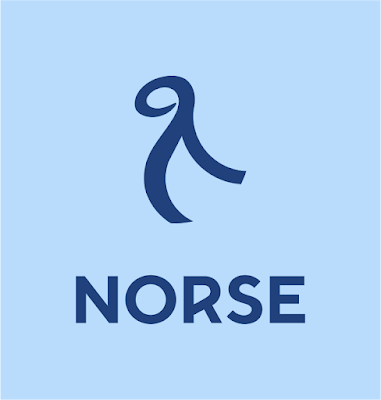
















































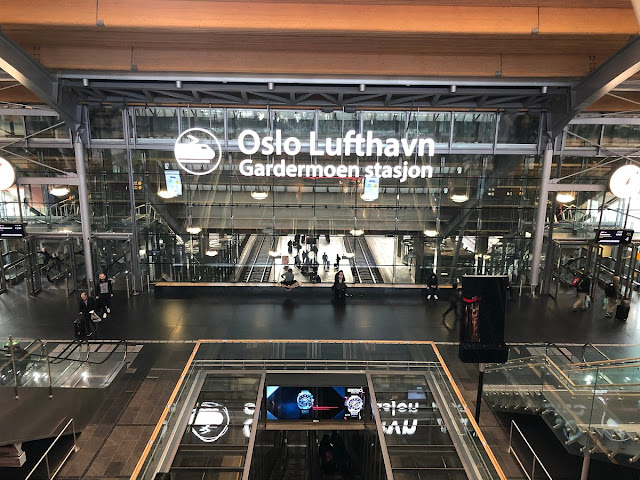













































































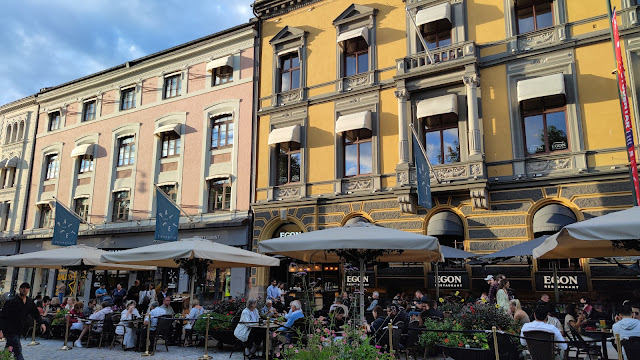
























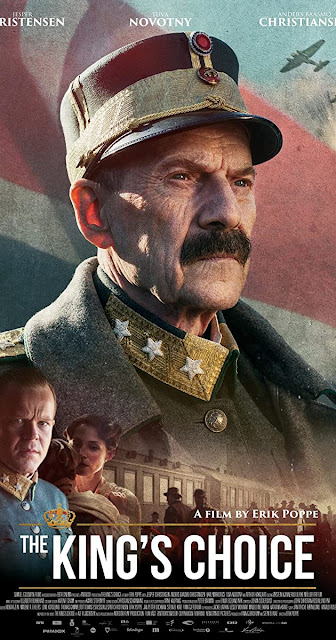






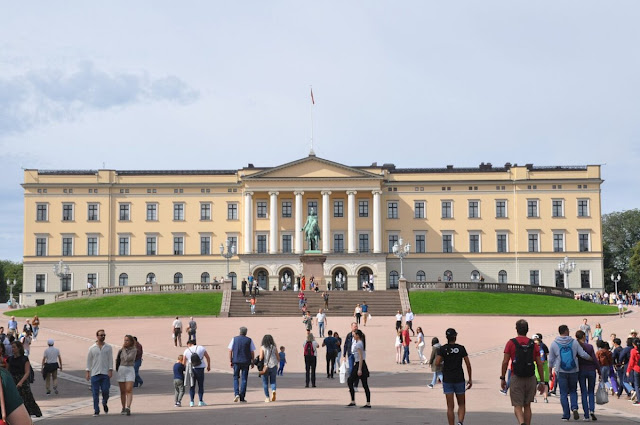













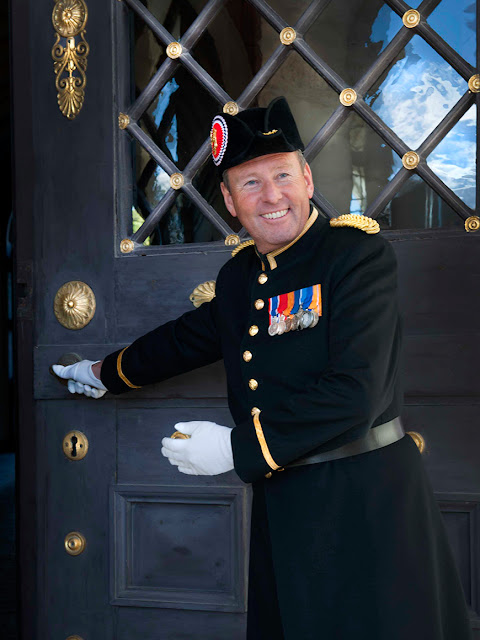
















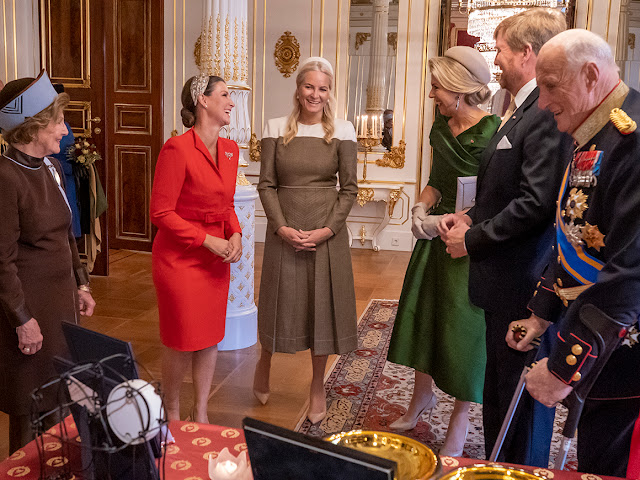









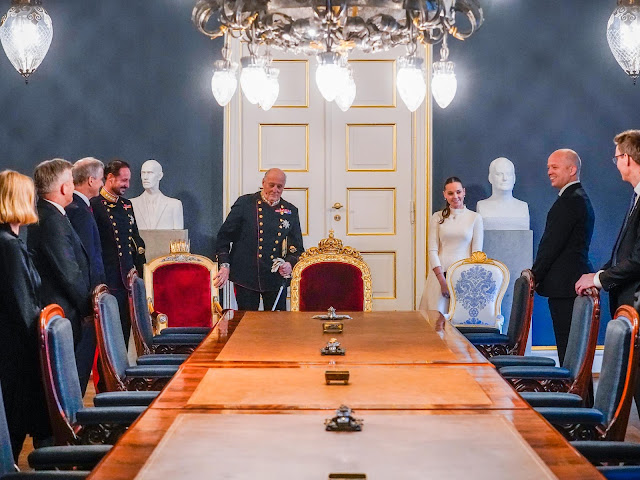


















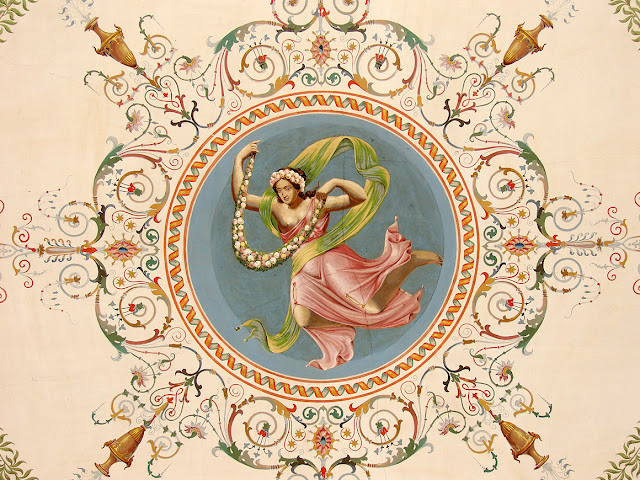














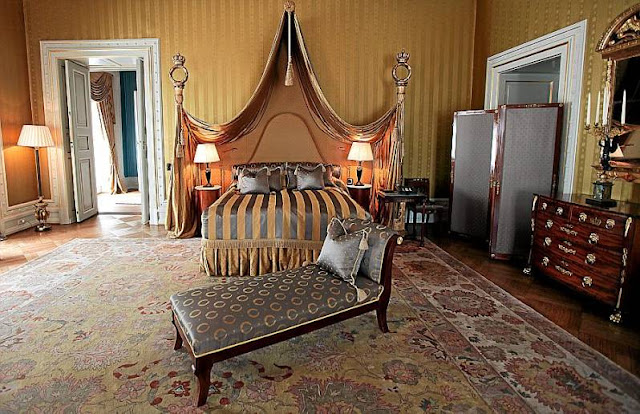


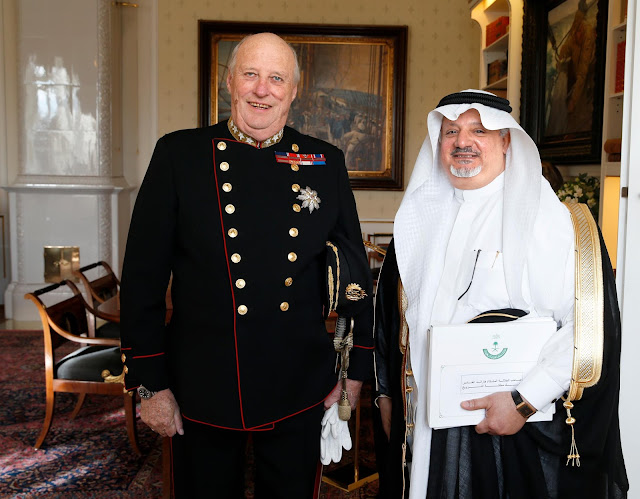


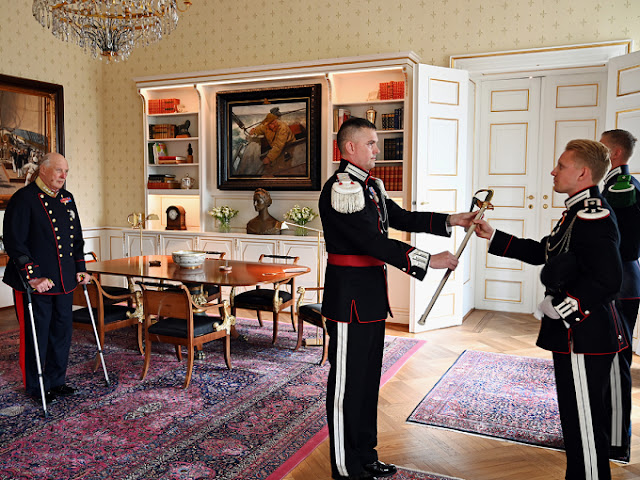













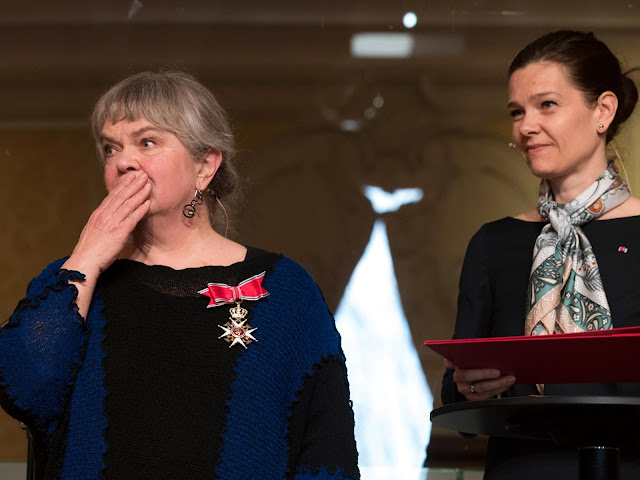
























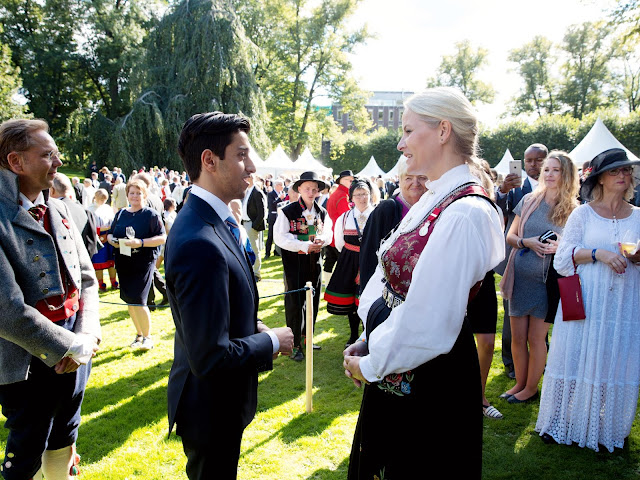

























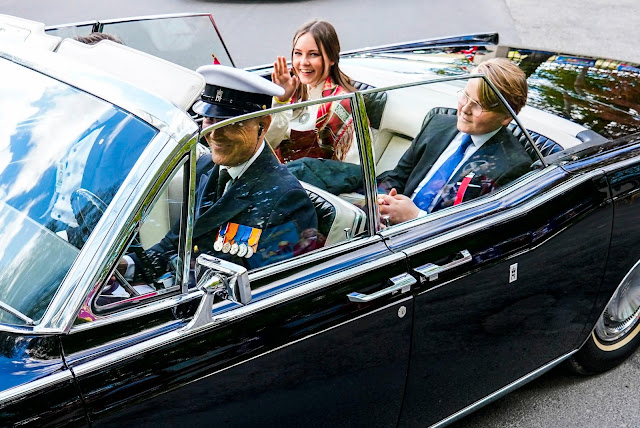
















































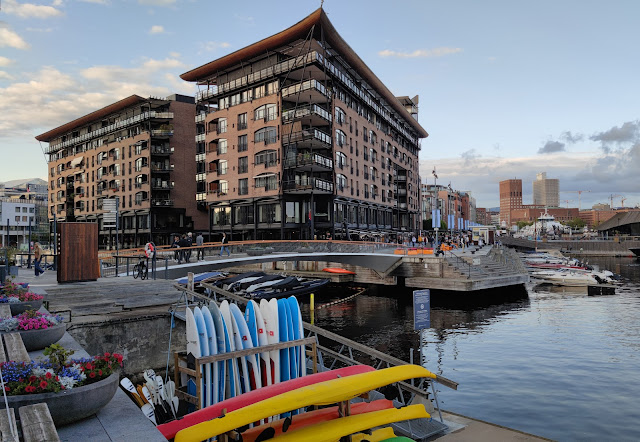





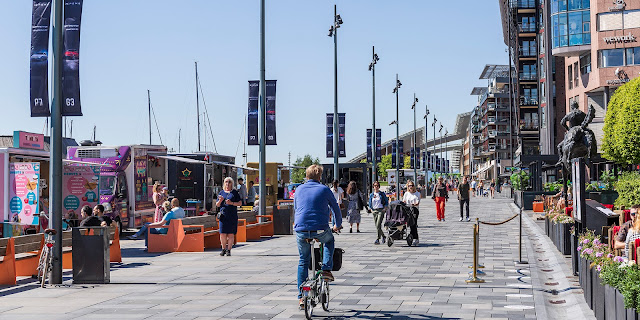

















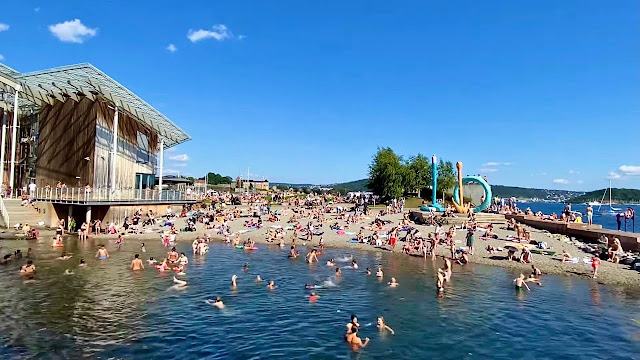


























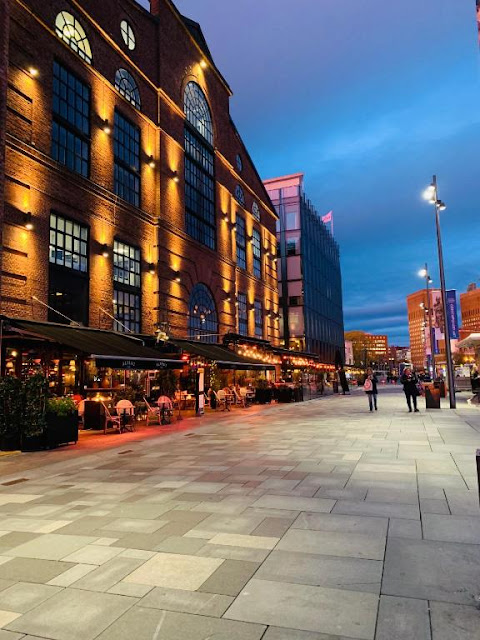
















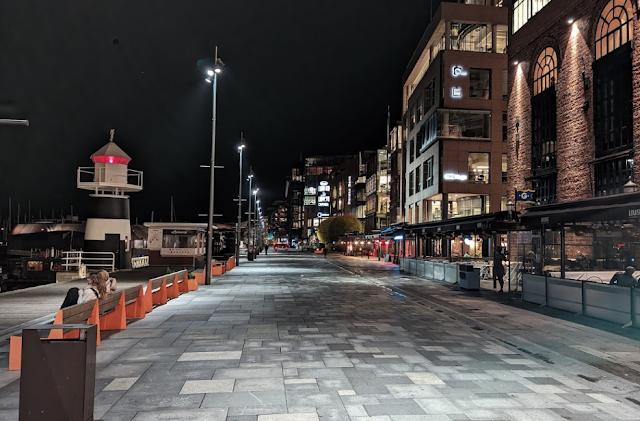



No comments:
Post a Comment
Don't be shy: leave your comments :)